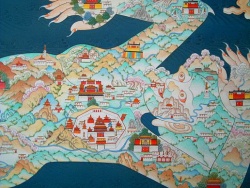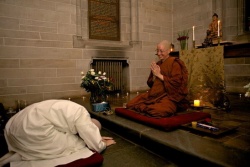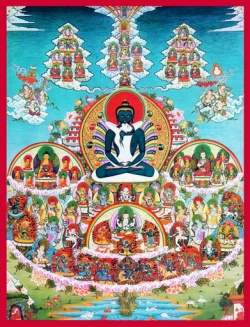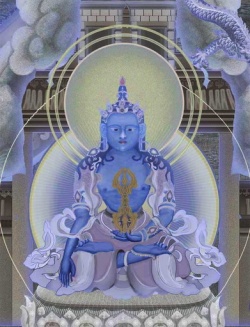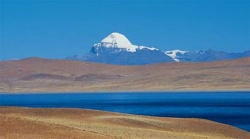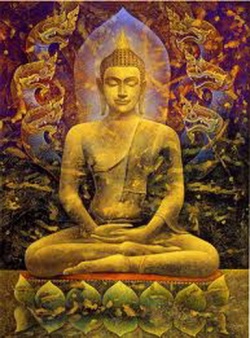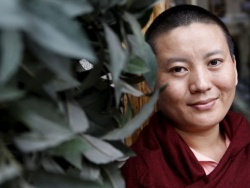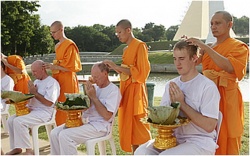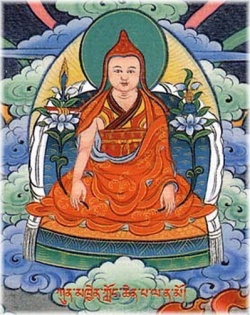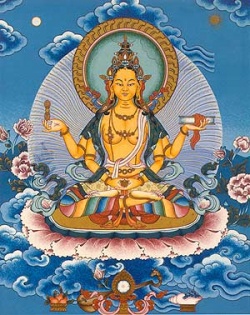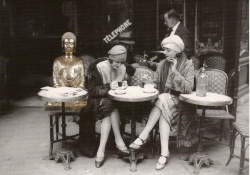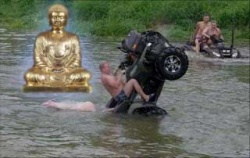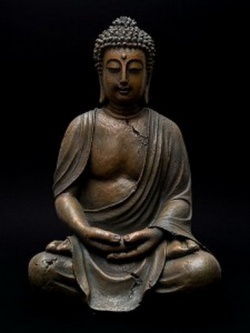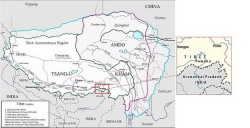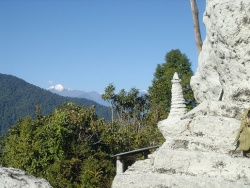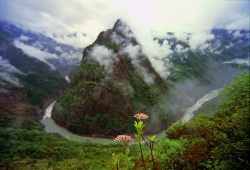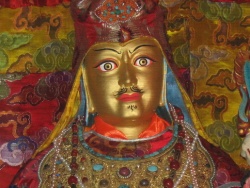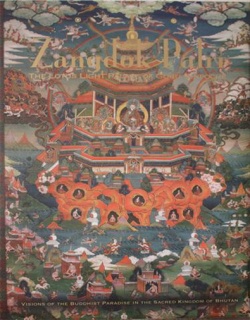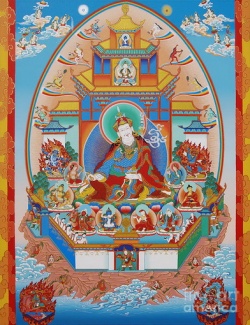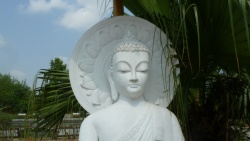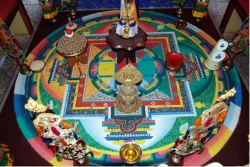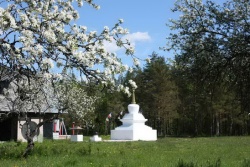Pemako
Pemakö (Wyl. pad+ma bkod) or 'Lotus Array' is perhaps the most famous of all the hidden lands (sbas yul), which according to prophecies, are to be revealed or 'opened' by tertöns throughout the Himalayan region.
It is located in southeastern Tibet, where the Brahmaputra river descends into India.
==Further Reading==
- Hamid Sardar-Afkhami, 'An Account of Padma-Bkod: A Hidden Land in Southeastern Tibet', Kailash, vol. 18 3&4, 1996
- Garje Khamtrul Rinpoche, The Lama's Heart Advice which Dispels all Obstacles: A Concise Guide to the Hidden Land of Pemakö, translated by Brian Gregor, 2002 (unpublished)
Pemakois a region located in the southeast corner of Tibet. Its name literally means "Lotus array" in the Tibetan language.
It Historically a hunting ground for Abors the region became famous specially during the visit of Guru Rinpoche in 8th century. Pemako is considered to be the most sacred place in Tibet, blessed with holy virtues.
Many popular Lamas visited the place in search of termas which were made hidden during crisis in Tibet, the most renowned Lama who was born in Pemako is H.H. Dudjom Rinpoche (1904).
Geography
Pemakoe (Pemakoe, Pemakod or Pema ko) is located in the altitude ranging from 2000 to 3500 meters above sea level, it covers 30,000 km2 of area stretching from south of Kongpo and Powo (Kham) through the lower Yarlung River (Brahmaputra) into Arunachal Pradesh (Tuting region),
surrounded by high mountains (tallest is Mt. Namcha Barwa 7,782m) with lush vegetation, one can find many species of wild animals in this part of Tibetan Plateau.
The region unlike other parts of Tibet receives plenty of rain hence, it is so diverse in nature that you can find subalpine conifer forests in the north to the temperate coniferous forest in the south in low lying area of River Tsangpo gorges.
In contemporary Tibet Pemako has become a mere historical name, it has been officially termed as Metok County (after Metok Dzong) or spelled by Chinese as Medog or Mòtuō irrespectively which is under Nyingchi Prefecture, Tibetan Autonomous Region.
According to Chinese govt, Metok county covers an area of about 30,000 km2 and has population of 9200 (2001 census) people.Maps of Pemako and Metok Dzong, Maps of Nyintri Prefecture and Minling county Mêdog
Mêdog is a village in the Tibet Autonomous Region of China.
Formally called Metok Dzong, it used to be the residence of Dzongpon (district head) representing the authority of Tibetan Lhasa Govt (Ganden Phodrang).
Metok town is located within the valley of the great bend of the river Bramaputra, its elevation is the lowest of all the counties of Tibet hence the town is abundant in vegetation and has rich flora and fauna. Metok is in the heart of Pema ko which connects the county with rest of the country.
Majority of Metok population is Pemakopas (a.k.a. Pemako Tshangla), with significant minority of Khampas, Kongpopas and Lhopas.
The Pemakö Region
The spatial extent of the Pemakö region can only be approximately determined.
It stretches down from the mountain range of Gyala Pelri and Namche Bawar in the north, on either side of the south and south-west flowing Tsangpo River2 until the McMahon Line as defined on British, Tibetan and Indian maps after 1914.
The western boundary seems to follow the mountain range with the Tamnyen La, Deyang La, Pepung La, and Doshung La connecting Pemakö and Kongpo.
The eastern boundary approximates to the southwards flowing Tsangpo, the Shumo Chu, the Kangri Karpo pass down to Tashigong in the Yang Sang Valley area that is bounded by the right bank of the Yang Sang River between Tashigong until Jido. 3
This area forms the southern part of Pemakö and, with three of its five major pilgrimage sites, constitutes the main pilgrimage area of Pemakö as a holy place. 4
Although Pemakö is often imagined and presented as an isolated region, accounts by British explorers and officers of the Indian administration show that it was rather a dynamic hub for peoples both from the Tibetan plateau and the lower hill regions to the south.
They came there in search of new places to settle, or on pilgrimage, or traversed the region on trade and tax collecting missions.
The imagined isolation of Pemakö might have emerged from the scarcity and nature of material from the past, which mainly focus upon religious aspects of its exploration and opening as a hidden land.
The Tibetan Buddhist concept of hidden lands in itself already conveys the idea of isolation and inaccessibility.
Observations at Phe in 1924 by the British naturalist Frank Kingdon Ward reveal a lively movement of people through Pemakö:
"The Mönbas were now crossing the Doshong La in hundreds, a few Kampas, Pobas, and Kongpobas with them; we also saw three Lopas - presumably the people we call Abors - who had come 25 marches.
They had all come to get salt, bringing rice, curry, vegetable dyes, canes […], maize, tobacco, and a few manufactured articles such as coloured bamboo baskets, garters, and so forth. […]
By the end of October traffic ceased, […] but at this time not a day passed without fifty or a hundred people coming over – men, women, and children – and Pe, with its camps, and supplies, and people coming and going, presented a lively scene.
Between one and two thousand must have crossed the Doshong La in October, which made Pemako appear quite thickly populated. But it is not.
The area of Pemako cannot be less than 20,000 square miles, and probably a third of the population come to Pe for salt each year. Most of the remainder go to Showa".
Measured against Kingdon Ward’s estimation of Pemakö’s spatial dimension, the region might have been sparsely populated but, as he notes himself, the number of people coming to Phe only comprised a third of the population.
The rugged mountain area of Pemakö allows little space for settlements and farmland. In relation to these stretches of inhabitable land, the population density was higher only along certain river valleys.
Up to the end of the 1950s, these valleys functioned as the major transport arteries between the Tibetan plateau and the lower hill regions.
Apart from these main routes, the region is criss-crossed by trails connecting the various villages within the Pemakö region.
Due to the increasing number of migrants flowing into Pemakö since the beginning of the 20th century, the native inhabitants of the region were, by degrees, displaced from their settlement areas, which often resulted in armed conflicts.
The spatial extent of settlement areas was closely connected with expansion of the Tibetan state’s territorial control in Pemakö.
By acting as the agents of the Tibetan administration, the Buddhist population of Pemakö established itself as a powerful community, one collecting taxes from other non-Buddhist groups beyond the border (McMahon Line) agreed upon by British-India and Tibet, and controlling exchange and interaction between the Tibetan plateau and the lower hill regions to the south.
This situation alerted the British authorities. In the context of the advance of Chinese troops towards Tibet at the beginning of the 20th century, they feared loss of the region as a convenient buffer zone between their Himalayan hill territory and the Tibetan plateau.
In order to exercise better control over their virtually unadministered territory, the British administration conducted several expeditions to Pemakö with the aim of building friendly relations between the administration and the population, as well as stabilising relations among the different tribal groups.
In addition to gathering much geographical and natural history data, British explorers recorded whatever facts they were able to obtain about the local populations.
The integration of the wide range of local peoples under British-Indian administration lead to pragmatically simplified classifications using exonyms at the time;
previous attempts to base such classifications upon local autonyms elsewhere in British Himalayan territories had resulted in thousands of identities being generated.
British classifications of Pemakö peoples were created according to the larger regions where migrants were thought to have originated from and the languages spoken in these regions.
The establishment of the category ‘Tshangla-speaking Memba’ and ‘Tibetan-speaking Tibetans’ forms the basis for the contemporary classification of Upper Siang’s Buddhist population.
The long-term result has been that, up to the present day, a variety of Pemakö groups are subsumed under these ST categories with an ascribed name that in many cases have no corrolation with their autonyms nor their own sense of origins and history.
History
Tibet as whole was ruled by small princely rulers, sometime called Pon-, Dzongpon and by some monastery. Pemako was no exception. It came under the rule of Powo king who ruled whole area of which defines Pemakoe (Now Metok county and part of Arunachal Pradesh (upper siang).
During Powo rule Pemako people had good relations with the Poba people, they jointly fought against Abors (Adis, mishmis etc.) who regularly disturbed the pilgrimage.
Hardly any people lived in Pemako before Tsangla migrants settled in the region, currently Pemakopas makes up the majority of the population.
As we always talk about Greater Tibet or Bhoet Chenpo at one time in Tibetan History all area of Drukyul, Dremong yul, Lha-dhak yul and Mon-yul were under the great king of Tibet,
half ancestor of Pemako peoples the Tsangla group immigrated internally to the land of hidden valley to escape aggression in their original homeland.
When first Tsangla people arrived in Pemako region they found that the land was unused,
they settled in the lower Yarlung valley, surrounded by Kongpopas in the northwest and Pobas in the northeast and Lopas in the south,
Tsangla adopted many customs from them but still retained their original language which they still speak at home.
By 1931 Tibetan national government was able to dismantled Powokingdom and region come under direct rule of central Tibetan Government, Lhasa.
Pemako region came into the jurisdiction of Tibetan central Government. Ganden Phodrang (Tibet govt) had its governor stationed in Metok Dzong who look after the territory and established communications between Lhasa and region of Pemako.
Hence tax to be paid to Tibet Lhasa govt which was compulsory for all the people living in the region in the form of cash or kind. Region of pemako was divided among different monastery and different aristocratic family.
Some region of Pemako pay tax to Sera monastery in form of grains, chillis, bamboo poles for prayer flags (Dharchen), products made of cane, medicinal herbs such as yertsa-goonbu, mushroom and animal skin.
Some regions of Pemako was under Kyabje Dudjom Rinpoche as monastic entitlement of nyingma lineage.
Head of the Tsang la requested powo for help fight against abor, but there was no evidence of powo ruled on Pemakoe and was unfamiliar in pemakoe.
Some books referred pemakoe was ruled by powo is an contradiction of the claim.
Migration
This study explores the history of migration by different Buddhist peoples from eastern Bhutan, the neighbouring Tawang area and the Tibetan plateau to the ‘hidden land’ (Tib. sbas yul) of Pemakö,
and the circumstances that induced migrants to leave their homelands.
The descendants of these diverse migrants who settled in the southern part of Pemakö - the Tuting, Geling and Singa Circles of Upper Siang District, Arunachal Pradesh -
became officially classified as the Memba and Khamba1‘Scheduled Tribes’ (hereafter ST) by the Indian administration during the early 1950s, in order to incorporate them all into the newly independent Indian state.
These ST categories were constructed on the basis of supposed common group origins and spoken language, and thus convey the impression that Upper Siang’s Buddhist population consists of two different groups, both of which are internally homogeneous.
However, both written sources of the British and post-independence Indian administration and my own fieldwork data demonstrate clearly that Pemakö’s Buddhist population traces its origins back to a wide variety of homelands.
Moreover, the ST labels are themselves exonyms that carry certain stereotypes and negative notions, especially the label Memba. Thus, both the Memba and Khampa labels meet with disapproval by local peoples so labeled.
The present study retraces the various migration histories and movements of Pemakö ancestor populations.
This allows some preliminary explanation of the autonyms used by these migrants themselves, in contrast to the generic exonyms, such as Memba and Khampa, that external agents haveapplied to them.
We can also demonstrate that, in large part due to the religious status of the region as a hidden land, Pemakö became an ethno-linguistic melting pot for migrants from many different places.
This diverse group nevertheless developed a common Buddhist identity vis-à-vis their nonBuddhist neighbours,
while simultaneously maintaining clear group boundaries among themselves according to place of origin and/or residence.
Migration from eastern Bhutan during the early 19th century
According to historical socurces, Orgyan Drodül Lingpa (b. 1757), recognised as the 5th reincarnation of the Kagyü master Gampopa, was a key 18th-century religious figure actively involved in the exploration of Pemakö.
By the end of the 18th century, due to his priest-donor relation with the king of Powo who controlled the region of Pemakö, Orgyan Drodül Lingpa travelled down the Tsangpo gorge. In a dream he received instruction to build a temple on a nearby hill.
The foundation to Rinchenpung was laid in 1806 and the temple became the centre of religious life in Pemakö.
It is reported that he, “[…] took under his wing […] [a whole] assemblage of inhabitants of Klo and Mon”and his teachings and activities became widely known. Today, a larger group of Pemakö’s population correlates its migration history with the agency of Orgyan Drodül Lingpa.
According to local Pemakö oral traditions, there was an important Lama in Lhasa whose name was Gampopa.
His fame had spread widely in Tibet and at the time when he went to Pemakö many people from eastern Bhutan accompanied him.
These people not only “were encouraged by the legendary reputation of these ‘hidden lands’”, the reason “to flee there in the 19th century [was] to escape from oppressive taxation in the area of eastern Bhutan and elsewhere”.
Local oral accounts describe this situation as follows: “The Mön king was very cruel. People had to work very hard for him. They started to look for a new place to live and so left Mön and thus they came to Pemakö.
First a few came and later more and more followed. ” On their way, these migrants were held up by local non-Buddhist populations described as ‘Lopas’ (Tib. klo pa), who only allowed them to pass through their territory after paying a toll.
Being unable to pay, the migrants had to stopover and their journey was delayed for almost two years. After their arrival in Pemakö the migrants leased a plot of land near Metog from the local Lopa, but the land was covered with trees and bamboo and inhabited by demons and spirits.
After these evil forces were expelled from the land the migrants used the wood and bamboo to build houses and they cultivated the land. The good news circulated and more than one hundred households followed.
In 1913, roughly a century after this major Bhutanese and Mönpa migration movement occurred, George Dunbar visited the Pemakö region and reported that:
“About a hundred years ago a band of emigrants from Darma [i. e. Bhutan) crossed the main range, it is conjectured by the Doshung La, and settled in the valley about Marpung, which is probably the oldest settlement. ”
From Marpung these migrants gradually spread “ousting the earlier inhabitants from the best land on either bank of the river, but permitting them to remain on their holdings in the unproductive tracts lying immediately below the gorge and about the 29th parallel”.
Even though these migrants counted themselves at the time as the fourth generation settled in Pemakö 29, their ties with Bhutan seem to have remained strong in certain respects, since they once in their lives went back to Bhutan to pay respect to the Trongsa Penlop.
The historical timeframes in the above accounts correspond to what Bailey was also told in 1913 by a man from Kapu, who claimed his grandfather to be one of the original migrants from Bhutan about hundred years earlier, but which Bailey interprets as “just another way of saying ‘a long while’”.
Bailey’s impression was that this time period “had not been so long that the immigrants were truly settled”.
However, in the early 1880s, Kinthup, one of the Pandit explorers, reports several settlements and monasteries between Pemaköchung and Mayum, and we can assume that at the beginning of the 1880s the Buddhist migrants had established them as a recognisable group in the region.
By the start of the 20th century, their settlement area stretched from Payi to Kopu on the right bank of the Tsangpo gorge, and from Pango to Mayum on the left bank.
Several of the non-Buddhist groups were engaged in conflicts with Memba settlers over the limited resources of land and food, and according to the situation they formed alliances among each other that were renounced as quickly as they were tied.
Bailey reports that, “[a]bout the year 1905 the Abors raided up the valley and burnt the village of Hangjo below Rinchenpung and penetrated as far as Giling.
Up to this time the Powo administration had allowed the frontier villages to settle their accounts with the Abors as best they could, but now became alarmed and sent troops down the Tsangpo valley to help their subjects on the frontier”.
These battles and the victory over the local non-Buddhist populations are still part of Memba memories in Pemakö.
In order to consolidate their authority, the Powo administration established an outpost, the Kala Yong Dzong, at Nyereng in the Yang Sang Valley around 1908.
This military takeover of the valley and the outpost offered security for Buddhist pilgrims and settlers coming down from the Tsangpo and Chimdro Valley.
During the following decades, this Powo Tibetan influence in the form of tax collection and trade control extended as far south as the villages of Karko and Simong.
Nevertheless, the main areas of settlement were, at least up to the beginning of the 1940s, located on the upper stretches of the Tsangpo Valley and, as Godfrey reports after a flight over the area up to Namche Bawar, only few scattered “Bhutia” villages were recognisable further down stream.
Migration from Tibet during the 20th century
During the early 20th century, various waves of migrants from parts of the south-eastern Tibetan plateau, a region generally known as Kham, first began to arrive in areas immediately adjacent to Pemakö, such as the Mishmi Hills to the southeast and Chimdro to the east.
In 1906/07, Noel Williamson reported a Tibetan settlement as established in the upper Dibang River area of the Mishmi Hills, whose settlers-originally arriving there for trade-came from the “province of Darge” [i. e. the Derge kingdom] in Kham at an unknown date.
In 1913, the British Mishmi Expedition explored the upper Mathun Valley and came across a colony of Kham Tibetans settled at Mipi.
They were refugees from a devastating flood in the Yidong Valley of Pome which had occurred around the turn of the century, and arrived in the Mishimi area via the neighbouring region of Chimdro.
A further group of about two thousand Tibetans from parts of Kham, Derge, Powo and elsewhere arrived in the Mishmi hills gain via Chimdro around 1902/03, guided by Jampa Jungne, the head of Riwoche monastery in Kham.
Jampa Jungne interpreted imperial China’s western expansion onto the eastern Tibetan Plateau at the time as a sign to depart for Pemakö, and thus escape military invasion and colonisation.
Disillusioned after conflicts with the local Mishmi inhabitants, and convinced that this place was not the hidden land they sought, the majority of the settlers returned to Tibet around 1909.
The numbers of migrants arriving around the Pemakö region from eastern Tibetan regions such as Chamdo, Dragyab, Gonjo and Derge gradually increased, and they mainly settled in the Chimdro valley and around Metog Dzong.
With their fellow countrymen on the southern side of the mountain range, these Tibetan migrants established extensive trade relations with several groups in the Abor Hills.
During the same period, the Yang Sang Valley within Pemakö became the centre of Buddhist activities, where Buddhist masters and their disciples wandered through the hills discovering religious treasures and establishing several pilgrimage sites that seasonally attracted larger groups of pilgrims.
Following the introduction of Indian administration several of these pilgrimage places fell into neglect because “[n]o Tibetans from across the border come nowadays for worship as they used to do in large numbers in the past”.
However, the number of permanent Tibetan settlers in Pemakö continued to increase.
While stationed at Tuting, Hranga noted in the 1950s that, “By enquiry I found that these villages came into being some 46 years ago […].
Some of the Khambas (and I think most of them) came from Chimdru. ”In 1944, James was told by the Head Lama Pema Yeshi that his father was the one who started the Khampa colony in the Yang Sang Valley.
At that time Pema Yeshi was a small boy. Around 1954 Lama Pema Yeshi died and his position as Head Lama was taken over by his son Sangtapji.
Whereas in 1944, only two permanent Tibetan settlements were reported at Nyereng and Tasigong with 23 houses in total,in 1956 the Buddhist population, most of them being Khampa, consisted of around 350 people and they had established several villages, small monasteries and nunneries in the valley. Not everyone coming down the Tsangpo or Yang Sang Valley was attracted merely by the pilgrimage sites.
Until the mid-1930s, the kingdom of Powo enjoyed a certain degree of independence from the Central Tibetan administration.
It is also said that the 26th Kanam Depa of Powo had a penchant for shady characters and surrounded himself with them, and the region became infamous for its marauding gangs.
The wilderness of Pemakö, and the fact that the southern part was controlled by the British and later Indian authorities, offered a good hideout for criminals, outlaws and tax fugitives as is reported in British and Indian administrative documents. The last major migration movement into Pemakö was set in motion around 1949/50 by China’s invasion in Tibet.
In the beginning of this exodus, the majority of these refugees came from eastern Tibetan regions hoping to return to their homes after some time, thus they established temporary settlements around Metog Dzong and the Chimdro Valley.
The situation in Chimdro must have been tense at that time and most likely due to a constant influx of new refugees, in January 1959 a “land dispute between the Rekho Khambas and the Riwoche Khambas caused [a] massacre of the former by the latter”.
Therefore more and more refugees desired to move further south into the Yang Sang Valley where not only the main pilgrimage sites are located, but also land was available.
However, after the establishment of the Indian administrative post in Tuting in 1953, entering Indian Territory became more difficult and people crossing the border usually had to ask for permission.
But not only Tibetan refugees have asked for permission to settle permanently on the Indian side.
A number of Pemakö residents from north of the McMahon Line went down on permits to visit the holy places and their relatives, and in fear they might settle in Indian Territory, the Dzongpön of Pemakö requested the Indian administration not to allow any of his people to settle south of the border without his approval,
to which the Indian officer agreed, since the Mishmi and Abor groups already had the feeling that Tibetans were encroaching on their land.
The escape of the Dalai Lama in 1959 was a final signal for thousands to follow him into exile, and many from the nearby region of Kongpo and Pome also set out to Pemakö in the hope of reaching an earthly paradise with an unending supply of food, rivers of milk, and where people didn’t have to work to make a living.
Often these refugees encountered Chinese troops on their way and many lost their lives or were captured and brought back. But those who were able to escape were welcomed by the local Buddhist population who provided them with food and shelter, as did the Indian Army.
On the eve of the Sino-Indian War in 1962, many of the Memba and Tibetan families who had been settled in the Tsangpo Valley above the McMahon Line for generations, abandoned their homes and also sought refuge in India.
This flow of refugees was finally stopped by the outbreak of the war in October 1962. From the mid-1950s until January 1962, the Indian administration registered 7004 refugees entering the Siang Frontier Division via Mechukha, Manigong and Tuting/Geling.
Most of them were eventually evacuated to different Tibetan settlements around India, but around 1000 were allowed to settle temporarily in Tuting.
The reason for all those who decided to settle permanently in southern Pemakö was the sacredness of the land, as I was informed. Ever since then, Tuting became the biggest settlement for southern Pemakö’s Buddhist population.
Nevertheless the main areas of distribution, with the Memba settling in the Tsangpo Valley between Tuting and Geling, and the Khampa/Tibetan in the Yang.
Ever since Pemako was first opened to outside world thousands of people from different walks of life settled in the region, among them, earliest were the Tshangla people from Eastern Bhutan who fled their homeland and took refuge there.
Among the first clans of Tshangla people were the Ngatsangpas (Snga Tsang pa)who paved ways for others to join them in their plight for a promised land free from sufferings.
The exodus of Tshangla community continued from beginning of the 18th century right until the early 20th century.
Political and religious turmoil in Tibet forced many Tibetans to join Tshangla people in Pemako a land where religious serenity pledge through many revered Lamas who had been to this land,
prophesied by Guru Rinpoche in the mid-8th century to be a land of final call where devotees would be flocking at the time of religious persecutions,
the last sanctuary for Buddhism, with the time Pemako's popularity grew more and more, with the popularity many Tibetan people particularly from Kham followed their Lamas and settled alongside Tshangla populace.
Over the period of time Tibetans and Tshangla migrants amalgamated to form an homogeneous group called Pemako pas ( Pad-ma dkod pa).
The process of infusion gave birth to a new Tshangla dialect called Pemako dialect. People who reside in Pemako enclave are of mixed blood originated from early Tshangla settlers and different Tibetan tribes, Standard Tibetan is also spoken in Pemako, with many different languages such Khampa language, Kongpo dialect, Poba Language etc.
Modern and Contemporary Pemako People
Since 1904 the year Kabgye Dudjom Rinpoche was born in Pemako, people from all over Tibet especially from Khams, Golok and Utsang, descended in Pemako and settled near their Lama.
Gradually intermarriage between the first settler and second wave settler produce what is today Pemakopa spread around the world.
Descendant of Pemakopa are hard working, strong, smart and intelligent people. Descendant of Pemakopa are spread across the Globe in this times.
Today Pemakopa has unique cultural identity and dialect that can be compared to any other region and dialect of Tibet. Tsangla is collequial of Pemakoe.
Eastern Bhutaness sharing same language in the form of text, therefore, Tsangla has text no longer use in Pemakoe.
Pemakopa means people of Pemako as a whole. People of Pemako include Tsanglha, Khampa i.e. Lhasawa, Rekhewa, Gonjowa, Nangchenpa, Golokpa, Kongpopa, Powowa, Zayulwa, Memba, Adhi, Mishimi and other Lopas.
Modern day Pemakopa descendent have the multi- ethnic roots.
Yarlung Tsangpo == Tsangchu in Pemakoe (not Yarlung Tsangpo)
River Tsangpo (Tsangchu) which originates from Lake Manasarovar in Western Tibet flows through 1500 km eastward when it reaches Mt Namcha Barwa, its bend making a U shape turn to penetrate into lower Himalayan ranges, thus curving one of the deepest Canyon in the world. Water dropping above 3,000 meters near Phe, about 300 metres at the end of the gorge.
The river is called Tsangchu a famous river in Pemakoe, like kyichu in lhasa.
Demography
Pemako is surely not an homogeneous society, different ethnic people lived here from many years, people like Pemakopas (Tsangla),
Kongpowas, Poba Tibetans and Lopas (Adi, mishis etc.) live here but Pemakopas make up the majority about 65-70% of the total population of 10,000-15,000, remaining are Khampas, kongpowas and Lopas.
(According to 2001 census in Metok county (Dzong) there are about 10,000 people ). In exile Pemakopa people spread through the world, but mainly concentrated in Tibetan Settlement of Miao choephelling, Tezu Dhargyeling, Tuting and area,
Orissa-Jerang camp, Tibetan Women Centre - Rajpur, Clementown, Delhi area, some in Europe and North America.
Language
The Tshangla dialect of Pemako (Tibetan: པདྨ་བཀོད་ཚངས་ལ་སྐད་, Wylie: Padma-kod Tsangla skad, also Padma kod skad) is the predominant language in the Pemako region of Tibet and an adjoining contiguous area south of McMahon line in Arunachal Pradesh in India.
Though Tshangla is not a Tibetan language it shares many similarities with Classical Tibetan, particularly in its vocabulary.
Many Tibetan loanwords are used in Pemako, due to centuries of close contact with various Tibetan tribes in the Pemako area. Pemako dialect has undergone tremendous changes due to its isolation and Tibetan influence.
Tsangla or Pemakopa is one of the many dialects of Tibet. Tsangla is widely spoken and understood by many non-tsangla speakers in the area.
As a Tibetan, people of Pemako also speak Shuong Ke or official Tibetan national language. Pemakopa people also speak other dialects of Tibet such as khampa, Kongpo and Zayul ke. Today inside Tibet pemakopa people are also well verse in Mandarin.
As majority are Pemakopas, Tsangla spoken is well established. If we talk about Tsangla language it is a branch of Tibeto-Burman bodish language which is mutually intelligible with those Tsangla in Eastern Bhutan.
The dialect has evolved into a new dialect as intermarriage between the first wave of settler and second wave of settler that came from kham, golok and ustang after the birth of Kyabje Dudjom Rinpoche in Pemako.
Contemporary pemakopa dialect is, a distinct, one of many and rich regional dialect of Tibet.
Tsangla or Pemakopa dialect doesn't have tones unlike Shoung Ke or Tibetan National language, but Tsangla language in Pemako has high and low sound, which is absence in other Tsangla speaking people of neighboring countries.
Pemakopa dialect numerical denomination up to 20 and higher number are counted in Shoung Ke or Tibetan National language. Globally Pemakopa or Tsangla dialect is spoken by about 140,000- 160,000 people.
Religion
People in Pemako follow Nyingma tradition of Tibetan Buddhism. Nyingma means old translation in Tibetan.
In Dec 2010 Chinese Govt connected the tunnel through Mount Galung la, which claimed to be connected Pemako to the rest of world throughout the year.
Source
Articles containing word "Pemako" in title
- (George Schaller, The Tigers of Pemako)
- A Road Trip to the Real Shangri-La
- An Examination of the Relationship between the Religious Heritage and the Natural Environment of the Tibetan Buddhist Hidden Land called Pemako
- An ethnography of memory in the secret valleys of the Himalayas: Sacred topographies of mind in two Beyul pilgrimages
- Beyul
- Beyul -- secret or hidden lands
- Beyul Demojong
- Beyul Nature Reserves
- Beyul Of Pemako – Paradise On Earth
- Beyuls
- Essential explanation of Pemako as the mandala arrangement of the five chakras of the wisdom goddess Vajravarahi
- Guidebook to the hidden land of Pemako
- Hollow Earth Theory and The Prophecy of Shambhala (Shangri-La) Part 2
- In Quest of Shangri-La
- James Hilton and Shangri-La
- Journey to the Hidden Land of Pemako
- Lotus-land or Pemako
- Odisha's Sambalpur: The 'Real & Original' Shangri-La
- Pemako's
- Pemako Ngakpa Lineage of Ogyan Tanzin Rinpoche
- Pemako – Vajrayogini’s Sacred Body
- Pemakod
- Prisoners of Shangri-La: Tibetan Buddhism and the West
- Prisoners of Shangri-La—Tibetan Buddhism and the West
- Shangri-La
- Shangri-Las
- Sikkim is still regarded as sacred land or Beyul by its Buddhist
- The Crystal Mirror Chronicle of the Supreme Sacred Realm of Pretapun within the Hidden Earthly Pure Land of Pemako
- The Road To Shangri-La - Full Documentary - TRACKS (Video)
- The Yangsang Pemako
- The original creation of the hidden pure land of Pemako
- Trek to the Beyul of Pemako
- Trekking in Pemako, Secret land of Guru Rinpoche
- Upper Pemako
- Where is Shangri-La? (Video)
- Yang Sang Pemako
- Yangsang Pemako
